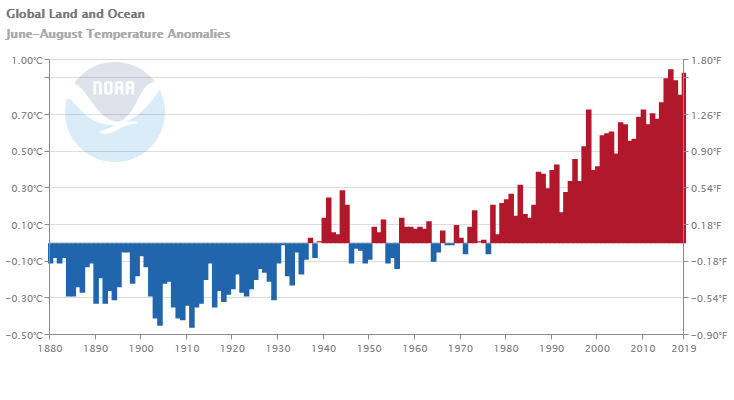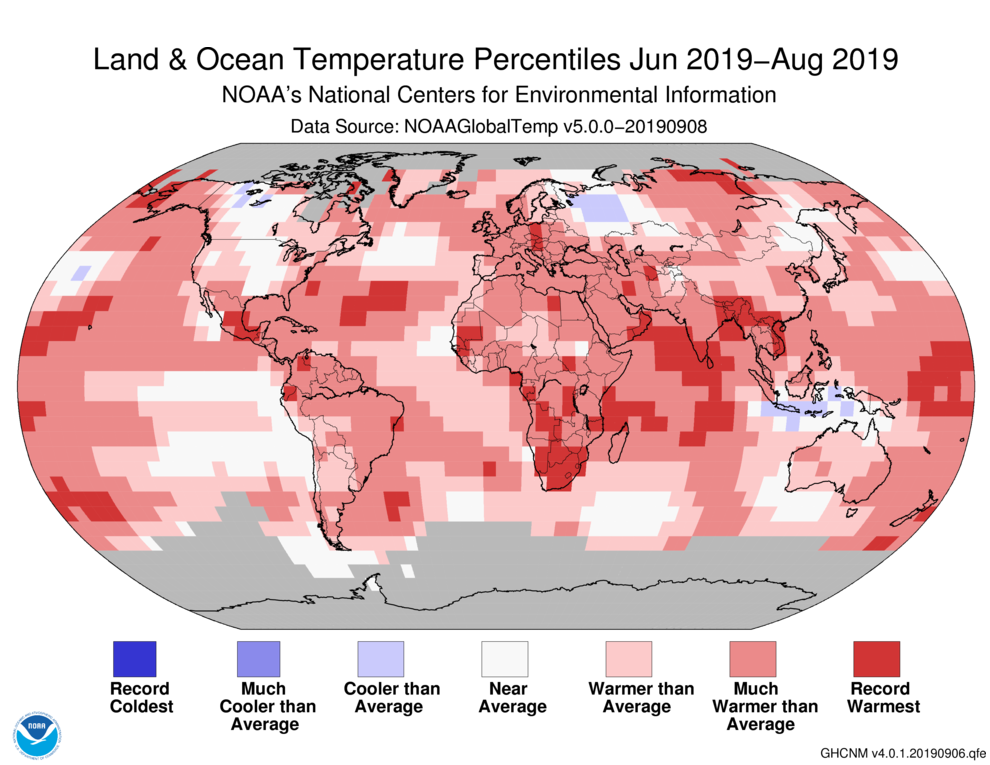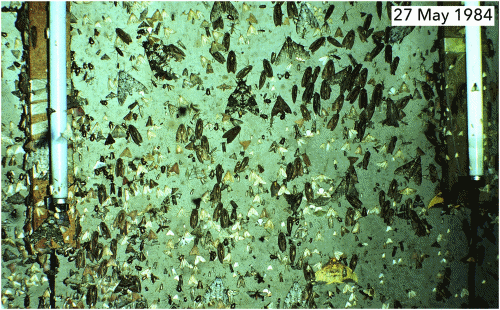Summer 2019 in the Northern Hemisphere tied for warmest summer on record – Five hottest NH summers have occurred in the past five years
By Andrew Freedman
16 September 2019
(The Washington Post) – The Northern Hemisphere just had its hottest summer on record since 1880, according to National Oceanic and Atmospheric Administration data released Monday. NOAA found the average global surface temperature taken by thousands of thermometers, buoys and other sensors on land and sea tied with that of 2016 for the top spot, with a temperature anomaly of 2.03 degrees (1.13 Celsius) above the 20th-century average.
In addition, August was the world’s second-hottest such month, according to both NOAA and NASA, with unusually hot conditions seen from pole to pole and across every ocean.
What’s remarkable about 2019′s record warmth is that it comes in the absence of a strong El Niño event in the tropical Pacific Ocean. Such events tend to boost global temperatures by warming the seas and sending more heat into the atmosphere. Instead, a weak El Niño has been present at times during 2019 but nothing like what occurred in 2016, which was the last time a Northern Hemisphere summer was this warm.
The Northern Hemisphere’s global land and ocean surface temperature for summer was 1.13°C (2.03°F) above average, tying with 2016 as the warmest summer on record. The Northern Hemisphere’s five warmest summers have all occurred in the last five years.
NOAA State of the Climate report, August 2019
As global average temperatures continue to rise in response to increasing levels of human-produced greenhouse gases, it is becoming easier to exceed climate benchmarks even without strong El Niño events. For example, according to NOAA, the five hottest summers in the Northern Hemisphere have each occurred during the past five years.
This summer featured unusual events that are symptomatic of a rapidly warming planet. There was a brutal heat wave across Europe in July that established new national high temperature records and broke Paris’s all-time hottest temperature. In addition, Arctic sea ice plummeted to the second-lowest level on record for the month of August.
Furthermore, the Arctic was ablaze, from the boreal forests of Alaska and Canada to the Siberian tundra and vast spruce forests, highlighting the possibility that the region could go from an absorber, or “sink,” of carbon to a source of additional carbon dioxide emitted into the atmosphere. [more]
The Northern Hemisphere just had its warmest summer on record
Global Climate Report – August 2019
17 September 2019 (NOAA) – The combined global land and ocean surface temperature for August 2019 was 0.92°C (1.66°F) above the 20th century average of 15.6°C (60.1°F) and tied with 2015 and 2017 as the second highest August temperature departure from average since global records began in 1880. This value is 0.06°C (0.11°F) less than the record warm August set in 2016. Nine of the 10 highest August land and ocean surface temperatures have occurred since 2009, with the five warmest Augusts occurring since 2014. August 1998 is the only August from the 20th century to be among the 10 warmest Augusts on record.
The global land-only surface temperature for August 2019 was the fourth highest August global land-only temperature in the 140-year record at 1.14°C (2.05°F) above the 20th century average of 13.8°C (56.9°F), trailing behind 2016, 2017, and 2015. Meanwhile the global ocean-only temperature departure from average for August 2019 was the highest on record at 0.84°C (1.51°F) above the 20th century average of 16.4°C (61.4°F). The August 2019 global ocean-only temperature exceeded the previous record set in 2016 by 0.02°C (0.04°F). This value also tied with September 2015 as the sixth highest monthly temperature departure from all months (1,676 months) on record. The 10 highest monthly global ocean surface temperature departures from average have occurred since September 2015. […]

Seasonal Temperature: June–August 2019
The June–August period is defined as the Northern Hemisphere’s meteorological summer and the Southern Hemisphere’s meteorological winter.
The June–August 2019 period was the second warmest such period in the 140-year record at 0.93°C (1.67°F) above the 20th century average of 15.6°C (60.1°F). This value trails behind June–August 2016 by 0.02°C (0.04°F). Nine of the ten highest June–August global land and ocean surface temperatures have occurred since 2009. June–August of 1998 is the only such period in the 20th century among the ten highest values on record. […]
The Northern Hemisphere’s global land and ocean surface temperature for summer was 1.13°C (2.03°F) above average, tying with 2016 as the warmest summer on record. The Northern Hemisphere’s five warmest summers have all occurred in the last five years. The Southern Hemisphere global land and ocean surface temperature for their winter tied with 2015 as the second highest winter temperature in the 140-year record at 0.74°C (1.33°F) above average. Winter 2016 was warmer by +0.02°C (0.04°F). [more]




